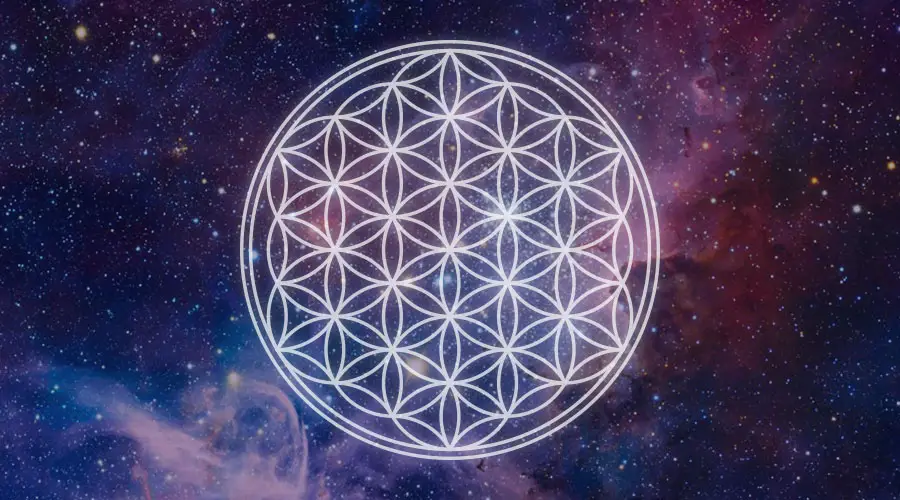The flower of life symbol is seen throughout the world and is full of symbolism and meaning. In this article we are going to look at what is the meaning of the flower of life.
The flower of life symbol contains the essence of everything in existence. All other geometric forms are found within it, including the Platonic Solids, Metatron’s Cube, and the Merkaba. Essentially it represents creation, and is the basic blueprint for all consciousness, and all that exists is based upon.
What does the Flower of Life symbolize?
The flower of life consists of nineteen overlapping circles, including two larger circles surrounding the outer edge. Together the circles form flower-like shapes, and by drawing straight lines between the node points where the circles overlap, all of the other geometrical shapes can be found. It is called a flower not just because it looks like a flower, but also because it represents the cycle of a fruit tree, which makes a little flower, and then goes through a metamorphosis and turns into a fruit. The cherry or apple or whatever kind of fruit that is created contains seeds within it, which fall to the ground and then become another fruit tree. This five-step process actually parallels the geometries of life.
Within the flower of life can be found other less famous symbols, that are like stages on the way to the development of the full flower of life. The Flower of Life is the process of Creation, and each of these shapes are a stage in its evolution, as it moves into full fruition. They are the following:
Vesica Piscis
The Vesica Piscis is formed when two circles are placed on each other’s circumferences. It is considered one of the most important relationships in sacred geometry. This relationship contains the Golden Mean proportion.

Seed of Life
The Seed of Life is the seven circles in the middles of the flower of life. It consists of six circles, plus a larger one surrounding them. It is like the early stages of a multi-cellular embryo. It has been found burned into the Three Osirian Temples in Abydos. It also contains the Kabbalah shape within it (more on that later).
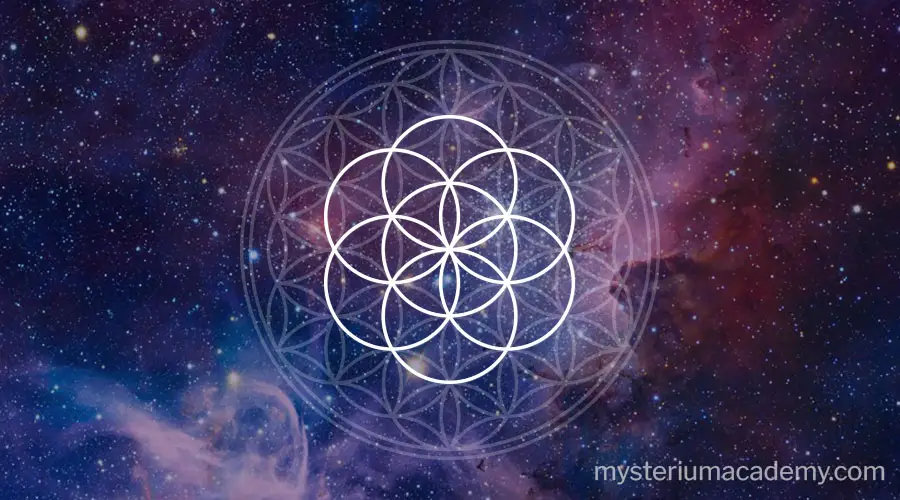
The Tree of Life
It is often believed that this symbol originated with the Jews or Hebrews, but in fact it goes way further back. The Egyptians were carving it on pillars 5000 years ago.

Egg of Life
Once consciousness projects the first seven spheres and completes this Genesis pattern, it continues to rotate until it completes its second vortex motion. That motion then completes a three-dimensional shape. This is the moment spirit can move outside of its creation and observe itself.

Fruit of Life
The Fruit of Life is thirteen circles, and is the third rotation of spirit. It is very important in the creation of our reality. The Fruit of Life is the beginning of the emergence of Metatron’s Cube.
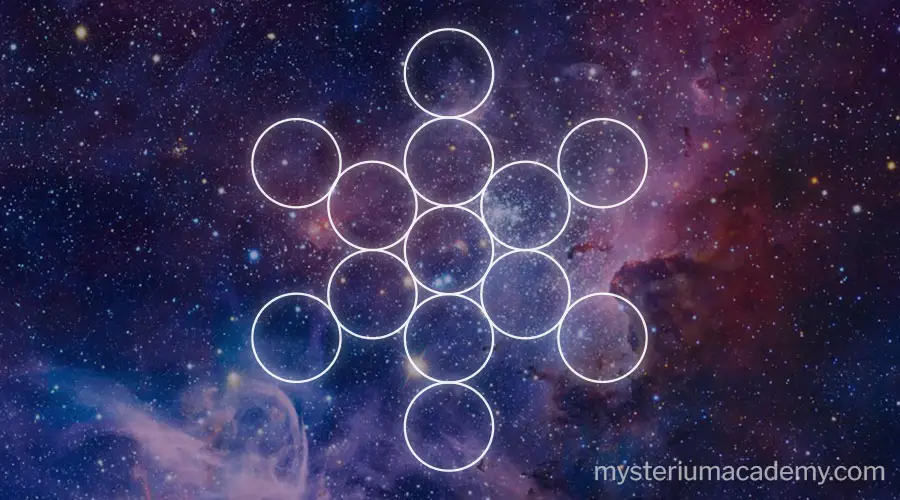
Metatron’s Cube
When you start to draw straight lines between the interceptions of the circles within the flower of life, you get the symbols known as Metatron’s Cube. Metatron is the Hebrew archangel who represents the perfection of what humanity is supposed to become. He is described as being blue and 55 feet tall. Within Metatron’s Cube there are the Platonic Solids: Tetrahedron, Cube, Octahedron, Dodecahedron, and Icosahedron.
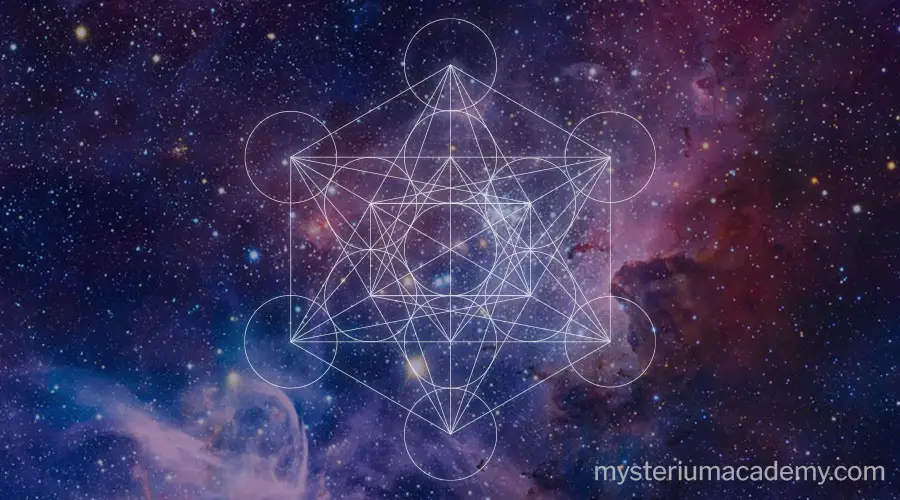
The Flower of Life Contains the Platonic Solids
The Platonic solids are characterized by the fact that all of their faces are identical, and meet at the same three-dimensional angles. The ancient Greek philosophers were deeply interested in the platonic solids, and were already discussing them by 400 BC. They owe their name to the Greek philosopher Plato (428–348 BC), who associated them with the four elements of fire, air, water, and earth. He proposed that all matter consists of a combination of these elements, and that the Tetrahedron is fire, the cube is earth, the Octahedron is air, and the Icosahedron is water.
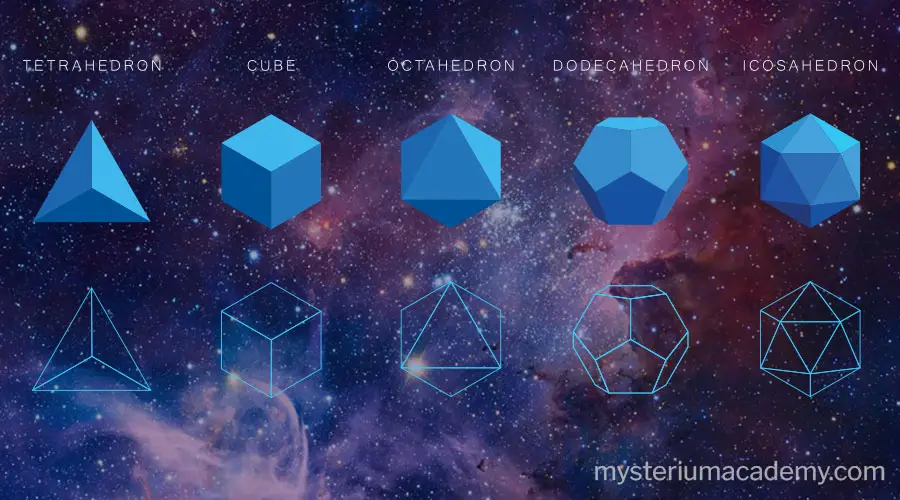
How do you use the Flower of Life?
A long time ago humanity existed in a much higher state of consciousness, and all knew that the flower of life was the creation pattern of spirit. It’s existence is present in our bodies.
The flower of life can be studied, contemplated, and meditated upon to achieve a greater understanding of creation and the universe. There are no rules to how the flower of life can be used. A deeper understanding can be had by drawing the flower of life, including all the symbols found within it, by hand, using a geometry kit. Because it consists of only nineteen circles, plus straight lines drawn between the intersections, all you need is a pencil, eraser, compass, and a straight edge.
The Merkaba Energy Field
One important application of the flower of life is the Merkaba energy field. When you take the Star Tetrahedron shape and make it three dimensional, rather than a flat 2D shape, it becomes the Merkaba. The word Merkaba comes from the Hebrew word for chariot, and refers to the concept of a vehicle of
The Merkaba is an energy field that surrounds the human body, and when in higher states of consciousness, it becomes activated and spins. There are specific meditations that can be practiced in order to wake up the merkaba, which lies dormant in most people. Activating it puts a person in a very different state of consciousness, and they can expect incredible synchronicity in their lives. It also balances opposing energies in a person, male and female, micro and macro etc, and activates protection around the person.
The merkaba appears in various traditions throughout the world. According to traditional Zulu wisdom, the Zulu people travelled to our world on a merkaba. It is also believed by some that a merkaba energy field can not only be activated around the human body, but also around areas of land where protection is needed.
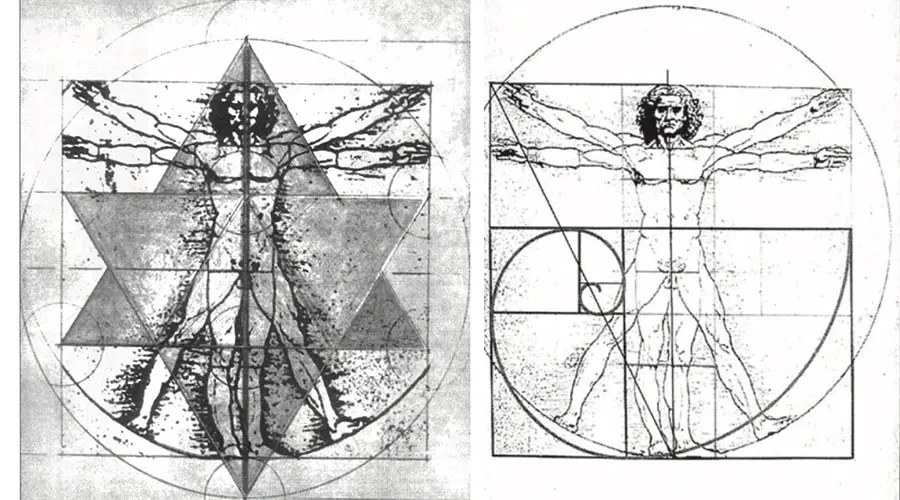
Who made the Flower of Life?
The symbol has been discovered in many ancient cultures across the globe, including Ireland, Turkey, England, Israel, Egypt, China, Tibet, Greece, Japan, in ancient Synagogues in Galilee and Masada, Israel, and in Assyrian art. Researchers have found the symbol in temples, burial sites, manuscripts, and many other places, the Rama temple of Vijayanagara in India, the Forbidden City of China, and throughout Europe in various churches and monasteries.
Some believe that the flower of life can even be traced back to great civilizations that existed before history, and that 16 000 to 13 000 years ago humanity experienced a descent from much higher consciousness, in which knowledge of the flower of life was common and well known, down through different dimensions of reality into the denser reality we now live in. During this fall of consciousness, we changed how we breath prana, which used to be related to an energy field surrounding our bodies, called a star tetrahedron. Another major change occurred to our pineal glands, which became much smaller. Contained within this gland is all of our understandings of the geometries involved in the flower of life.
The Flower of Life in Ancient Egypt
Archeological evidence of the flower of life goes back to at least 6000 years ago, as seen in the three Osirian temples in Abydos in Egypt, which were built by Seti the First and dedicated to Osiris. Mysteriously, the faint but precise markings on the wall of the temple are not carved, but rather burned into the rock, using some unknown technology. The temple was discovered in 1902, and fully uncovered in 1926.
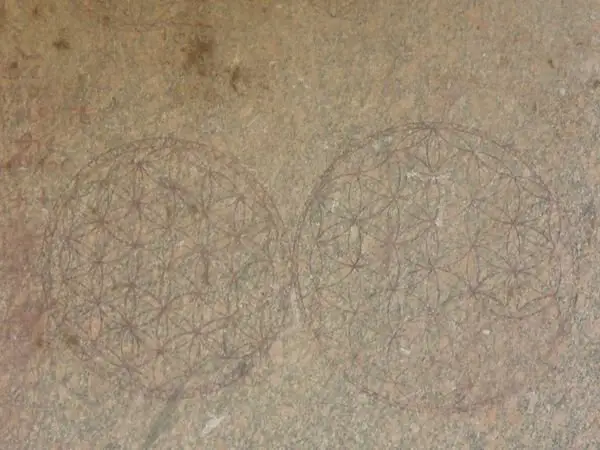
The Flower of Life can be Found in the Forbidden city of China
In the Forbidden city in Beijing, China, the flower of life can be found carved into the spheres under the paws of the Fu dogs. The Fu dogs are a symbol of protection, and considered to be guardians of knowledge. Construction of the Forbidden city began in 1406 during the Ming dynasty. Access to the Forbidden city was extremely restricted, and used for ceremonial purposes by the emperor. The layout of the city is based on Feng Shui principles.
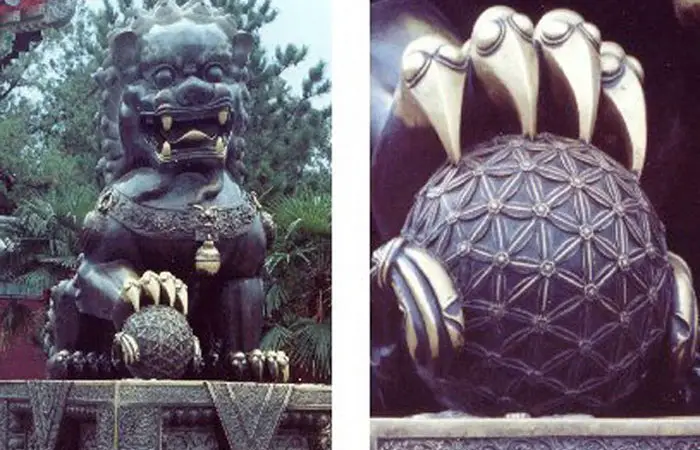
The Flower of life in Temples, Cathedrals, and Churches in Europe
Some of the locations include Sweden, France, Czech Republic, Germany, Bulgaria, and Greece.
- The ceiling of the Maria Luschari church in Italy
- In a Cathedral in Cordoba, Spain
- The Pompeii ruins in Italy
- In Churches in Sorg, Austria, and Gotland, Denmark.
- In Dresden, Germany on silver wear that belonged to Augustus II
- An Orthodox Christian monastery in Kreta, Greece
The Flower of Life in India
The Flower of life is seen in the Rama temple in Vijayanagara India. This temple is dedicated to the Hindu deity Rama. It is adorned with many decorations in addition to the flower of life, including depictions of the epic story of Ramayana.
The flower of life is on the floor of the Golden Temple in Hampi India. This temple is a Sikh religious center, and is known for preaching human brotherhood and equality. It was constructed in the 14th century.
The Kaballah and Other Spiritual Traditions in the Flower of Life
The most well-known religious symbols, such as the cross from Christianity, the Tree of Life or Kabbalah from Judaism, plus the Celtic Spiral, Hindu Swastika, and Chinese Yin Yang symbol are all within the flower of life.
The Jewish mystical practice of Kabbalah is contained in the flower of life. It consists of 10 spheres, known as Sefirot, which represent the ten archetypal numbers, and is the central symbol in the mystical practice. The sefirots, as well as the paths that connect them, can all be overlayed upon the flower of life. Between the sefirots are 22 paths, which are channels of energy that join the sefirots together. As a whole, the tree of life represents God’s creation out of nothingness.
Leonardo Da Vinci Studied the Flower of Life
Known for his incredible art and inventions, books have been discovered which show Leonardo was an avid studier of the flower of life. It’s influence can be found in his paintings, where to the trained eye he reveals great knowledge of the platonic solids, the torus, and other concepts derived from the flower of life. The proportions of his work, such as the famous David sculpture, contain the Golden Ratio, which is why they are perceived as being so aesthetically pleasing. The Golden Ratio is derived from the flower of life. Perhaps most famously, Da Vinci’s Vitruvian Man exemplifies his consideration of these metaphysical principles. The male figure inside of a circle and a square shows what he considered to be a divine connection between the human form and the universe.
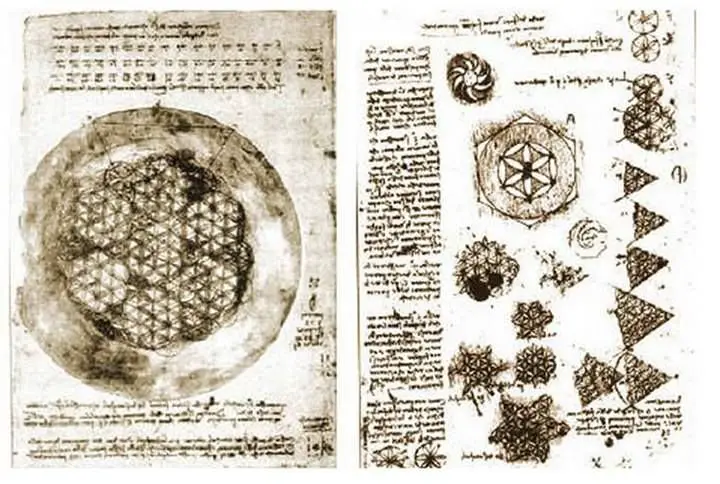
Worldwide Resurgence in Interest in the Flower of Life
Recent times have seen renewed interest in the symbol, as well as sacred geometry in general, along with meditation and other spiritual practices. The popularization of the flower of life in recent decades is often attributed to a man named Drunvalo Melchizedek, who began teaching workshops in the 1980s, and published two books on the subject. This emerging culture has been described as the New Age culture. But humanity has been aware of and studied the flower of life for at least thousands of years, according to the archeological evidence.
Recommended Reading
If you’d like to continue researching sacred geometry or any of the other topics discussed on this website, you can see which books I recommend by clicking here.

